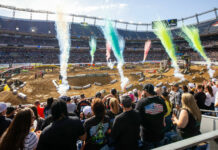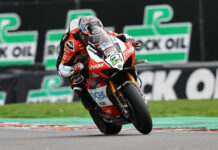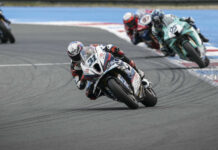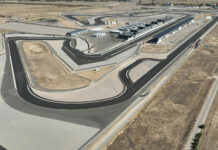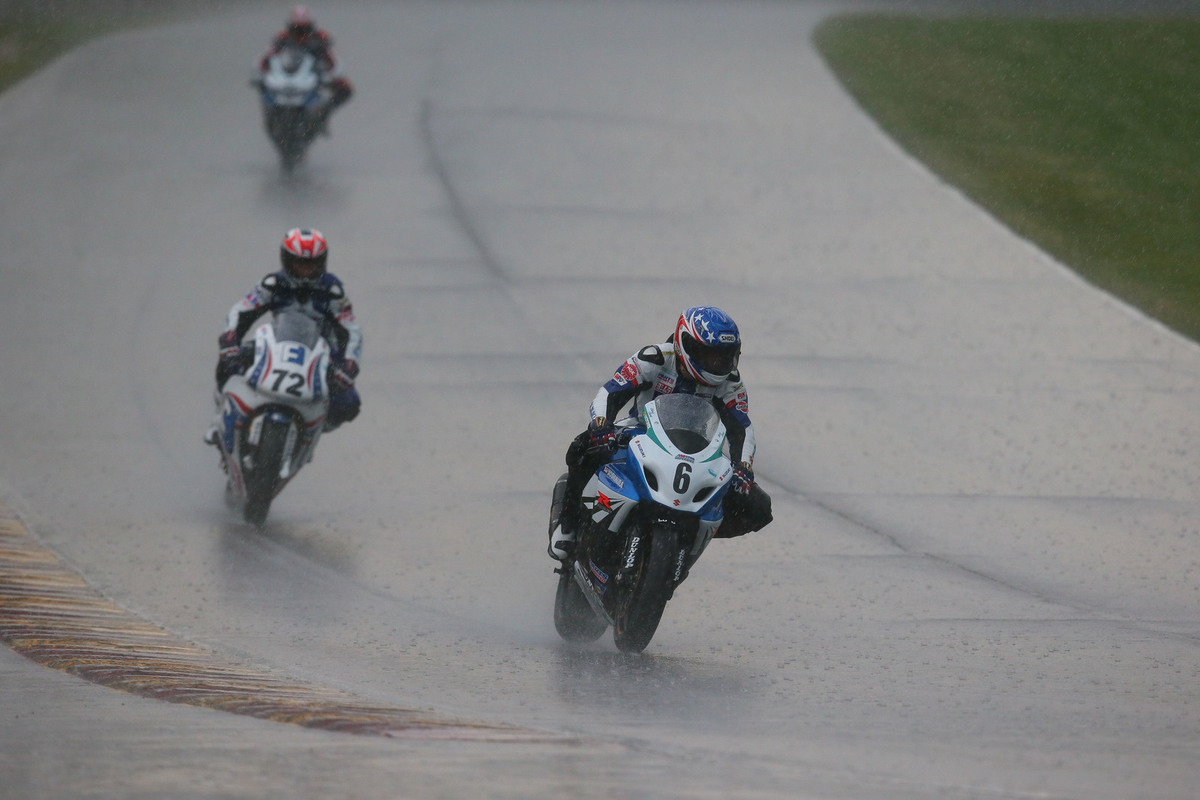Roadracingworld.com conducted a “best practices” poll of motorcycle race directors and senior officials, presenting each with the same hypothetical race and weather scenario, and asked what they would do if they were in charge.
Roadracing World’s Scenario: The field is racing on dry-weather tires and it starts raining hard, visibility is reduced and there is cloud-to-ground lightning in the vicinity of the track. You’re running the race. What would you do? And if your answer is “stop the race,” are there any circumstances in which you would not stop the race?
Here are the answers we received:
Stuart Higgs, Series Director, MCE British Superbike Championship:
“I always try to declare ‘dry.’ So you’re compelled to stop if it rains and then the restart is automatically wet. Declaring a race wet if the track is bone dry but you think it might rain isn’t really using the purpose of why we have the option of wet and dry races.”
Colin Fraser, Owner of Professional Motorsports Productions, organizer of the Mopar Canadian Superbike Championship:
“In Canada, we have to deal with lots of issues regarding the weather, particularly with rain/fog/cold, similar to what organizations face in the American north west. Television requirements can complicate the formula for go/no-go, but a red flag is a straight up Rider Safety issue. Your question is, in fact, very easy, since you included ‘cloud-to-ground lightning.’ Such conditions are a risk for Competitors and Event Staff, with the isolated, wired-in Marshals a major concern. So a stoppage would be a no-brainer. In CSBK, we would stop with a Red Flag.
“We have faced similar scenarios at Atlantic Motorsport Park in Nova Scotia, Calabogie Motorsport Park in Ontario and the old Race City in Calgary, Alberta in the recent past.
“Because of the urgency of the situation you described, there is no circumstance where we would wait to stop – even if we were trying to get the race completed, or up to 70% to be considered legal, or up to 50% completed for ‘Force Majeure,’ as per the Rulebook – the risks would be too great to continue.”
Sean Clarke, Operations Manager, WERA Motorcycle Roadracing, Inc.:
“Especially with the lightning, we shut it down. With no lightning and enough time to warn riders via flags I could see not stopping it if it’s an endurance race, as they can come in for pit stops and change tires (something that has happened in the past). Other than that, I can’t imagine a situation where we wouldn’t stop a sprint race.
“With conditions that aren’t as cut and dried I have waited and tried to get input from the more experienced riders as they come by the start/finish [line], however that’s more of a light mist/drizzle scenario. If we have a downpour on part of the track and dry on other parts we shut it down. We’ve done it a number of times this year. We’ve even pulled riders off the grid at NOLA when it started raining hard on the warm-up lap.”
Jim Sublet, Race Director, WERA Motorcycle Roadracing, Inc.:
“No question. Stop the race.”
Kevin Elliott, President ASRA LLC (dba CCS Racing):
“As a Race Director, I would stop the race for lightning within five miles of the track first, regardless of any other circumstance. Was it raining so hard the corner stations could not directly see each other? If so you must stop immediately. If the corners can see each other, visibility is not the reason to stop.
“The dry tires poses a different scenario. Was the race declared wet? If so, the tire choice was made by the teams with full understanding that we would not stop again. If by chance a rider took the chance it was going to rain, started the event on intermediates or full rains, then you penalize him by stopping the event for rain.
“If the event was never declared wet, you are obligated to stop the event for whatever change-over period you have established. If the event was declared wet and then the track fully dried, the Race Director could declare the event dry but then would be obligated to stop again for wet conditions. This is very unusual and not likely at an ASRA/CCS event with 15-20 races during the day.
“The Race Director still has the authority to stop a race for any reason he deems necessary, including but not limited to weather.”
Eric Kelcher, ASRA/CCS Racing Director of Competition:
“The lightning in the vicinity will trump all other circumstances, rain or not, in calling for race stoppage and seeking cover for all; racers, staff, spectators.”
Phil Sberna, ASRA/CCS National Referee:
“My answer to your question is I would stop the race if the lightning is close enough to be a danger to the riders and the cornerworkers! The multiple incidents would also tell me it is unsafe to continue. Once the hazard is gone I would continue with the race with the tire choice up to the competitor. If the race is 80% complete at this time it would be declared complete. During the red-flag time repairs and tire choices are unlimited. So what I’m saying once we are ready to restart we are not waiting for you. With all ASRA races this discussion is weighed with Race Director, myself, and Kevin (Elliott) if necessary.”
Rick Breuer, CCS Race Director:
“The sky-to-ground lightning would stop everything with little exception. Our cornerworkers and racers would be in jeopardy at that point. I would stop the race, declare it a wet track for tire changes. The down time would be 10-15 minutes after the last local lightning strike (with a 15-minute minimum for tire changes). The only possible way that the race would be allowed to finish would be if there is less than a lap left for the leaders. And even then it would depend on the lightning’s intensity and location.”
Henry DeGouw, President CCS Florida:
“We had a situation somewhat like your question last weekend at Homestead. On Sunday at 16:40 we declared the rest of the day’s racing as a ‘wet race’ and gave the riders 20 minutes to change tires. We then started the next race and after just short of three laps we had lightning strikes in the area along with heavy rain. We then red-flagged the race as too dangerous to continue. In the end we were unable to complete the remaining races and they were postponed to the next event. By taking the action we did after declaring a ‘wet race’ answers what we would have done if the field was on slicks!”
Jay Tanner, Race Director, CVMA:
“Absolutely stop the race, especially if there is cloud-to-ground lightning in the vicinity! I think you would be endangering everyone out there if you didn’t stop the race. Under that scenario, there is absolutely no circumstance that would keep me from stopping the race. The only time I might not stop it would be if a cloud is on the edge of the track and it’s only raining lightly in one spot of the track, but even then I would keep an eye on it to make sure it isn’t getting worse and watch to see if the leaders are signaling that it’s unsafe.”
Jim Wilson, President/Race Director, Motorcycle Roadracing Association (MRA):
“With the scenario you have listed, I would stop the race. There is no circumstance that I would not stop the race. Safety is our number one priority. Even if the field was on rain tires, the cloud-to-ground lightning is a great enough hazard to stop it.”
Steve Aspland, Race Director, Loudon Road Racing Series (LRRS):
“I would stop the race, give the riders 15 minutes to decide on tires and we will all wait until the lightning moves off. We have the track workers’ as well as the riders’ safety to consider. With lightning dancing around the track property we would have everyone get under cover. With the conditions you placed, we would always stop the racing even if it had rained earlier and dried out but everyone was caught off guard with dry tires when an unforeseen cell moved in. Safety first.”
Note: These same poll questions were also sent to the Race Directors for the FIM MotoGP World Championship, the eni FIM Superbike World Championship, the FIM CEV Repsol International Championship, the Australian Superbike Championship, the Swann Insurance Australasian Superbike Championship, AFM, OMRRA, UtahSBA and WMRRA.


